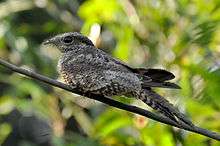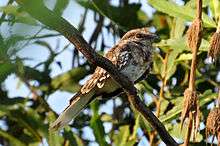Ladder-tailed nightjar
The ladder-tailed nightjar (Hydropsalis climacocerca) is a species of bird in the family Caprimulgidae, the nightjars. It is one of two species in the genus, Hydropsalis.
| Ladder-tailed nightjar | |
|---|---|
 | |
 | |
| Top, female; bottom, male | |
| Scientific classification | |
| Kingdom: | Animalia |
| Phylum: | Chordata |
| Class: | Aves |
| Order: | Caprimulgiformes |
| Family: | Caprimulgidae |
| Genus: | Hydropsalis |
| Species: | H. climacocerca |
| Binomial name | |
| Hydropsalis climacocerca (Tschudi, 1844) | |
It is found in the Amazon Basin of Brazil with the Guianas, Guyana, Suriname, French Guiana, and also Amazonian Colombia, Ecuador, Peru and Bolivia; it is also in Venezuela. Its natural habitats are subtropical or tropical moist shrubland, rivers, and freshwater lakes.
This bird is highly camouflaged and has the colors of 'ground cover', as do most of the nightjars. The colors are broken with white patches, grays, both dark, and light, and some brown, especially around the neck and head. Many of the nightjar species also have the distraction display, which helps lead unwary predators farther distances from the nest, young, or eggs.
As a species that hunts airborne insects, etc. at night, its large eyes are noteworthy; a large wide mouth also goes along with this feeding strategy.
Distribution
Amazon Basin, Guianas and upper Orinoco River Basin
The ladder-tailed nightjar is found in all regions of the Amazon basin, and in the northeast the Guiana Shield and the Guianan countries; its range does not extend east of the Amazon River outlet, (the island: Ilha de Marajo). At this same outlet, in the region of the Xingu River confluence, the range extends southward and is in the lower two-thirds of the drainage of this north-flowing river.
In the west the species range is adjacent to the Andes foothills. In the north, the range extends into southeastern Venezuela, and only the upper third of the Caribbean north-flowing Orinoco River drainage, the area of the eastern Orinoco River Basin and uplands bordering western Guyana.
In the very headwaters of the southern Amazon Basin, the upstream half of the river drainages, both in the southeast and southwest, the range overlaps with its sister Hydropsalis species, the scissor-tailed nightjar, which ranges into southeast Brazil through the caatinga, cerrado, and pantanal south into Argentina. The two species cover all of South America east of the Andes cordillera from central Argentina to the Caribbean coast; the exception is a small region centered southeast of the Amazon basin in the vicinity of Maranhão, Brazil.
References
- BirdLife International (2012). "Hydropsalis climacocerca". IUCN Red List of Threatened Species. 2012. Retrieved 26 November 2013.CS1 maint: ref=harv (link)
External links
- Ladder-tailed Nightjar photo gallery VIREO Photo-High Res-(Close-up)
- Photo-High Res; Article pbase.com
- Photo-High Res-(Night photo: Spot-lighted eyes); Article ib.usp.br—"Caprimulgidae"
